A view from behind the scenes
 This was Waveney and Blyth Arts’ second residency at Potton Hall. Thirty-eight artists submitted work for the trail on the theme of Between Two Worlds. It was pleasing to note that nearly a quarter of the exhibitors were first timers with Waveney and Blyth Arts. The result was an eclectic mix of approaches, materials and interpretations. It was lovely to hear animated discussions about the trail as people passed through our reception marquee, and this was also reflected in the highly appreciative comments which were made both verbally and in our visitors book.
This was Waveney and Blyth Arts’ second residency at Potton Hall. Thirty-eight artists submitted work for the trail on the theme of Between Two Worlds. It was pleasing to note that nearly a quarter of the exhibitors were first timers with Waveney and Blyth Arts. The result was an eclectic mix of approaches, materials and interpretations. It was lovely to hear animated discussions about the trail as people passed through our reception marquee, and this was also reflected in the highly appreciative comments which were made both verbally and in our visitors book.
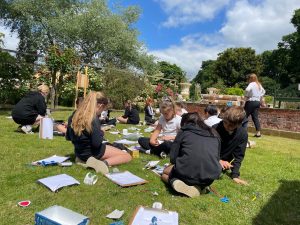 This year we were approached for the first time by two local schools – Somerleyton Primary and Bramfield House – asking if they might visit as an enhancement for their arts curriculum programme. The children really enjoyed the experience. Somerleyton pupils did some quick sketching facilitated by Grace Adam and the older students from Bramfield House engaged animatedly with their teachers and Cindy over their interactions with many of the works on display.
This year we were approached for the first time by two local schools – Somerleyton Primary and Bramfield House – asking if they might visit as an enhancement for their arts curriculum programme. The children really enjoyed the experience. Somerleyton pupils did some quick sketching facilitated by Grace Adam and the older students from Bramfield House engaged animatedly with their teachers and Cindy over their interactions with many of the works on display.
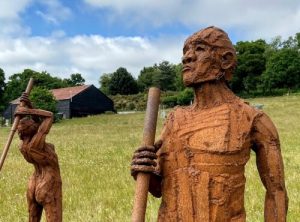 The end of trail ceilidh with Syzewell Gap and Jon Hooton was a lovely way to bring SitV to a close. Everyone enjoyed the music, dancing and chat and Simon anounced the winner of the public’s vote for most popular artwork – Standing for Something in a Changing World by Tobias Ford. He also announced the names of those who received in excess of 100 votes for their work – Meg Amsden, Mike Challis, Harry Chrystall, Cindy Lee Wright and Nick Ball. What is particularly pleasing is the fact that everyone received several votes and that all of the arts genres and aesthetics were well represented in terms of public support.
The end of trail ceilidh with Syzewell Gap and Jon Hooton was a lovely way to bring SitV to a close. Everyone enjoyed the music, dancing and chat and Simon anounced the winner of the public’s vote for most popular artwork – Standing for Something in a Changing World by Tobias Ford. He also announced the names of those who received in excess of 100 votes for their work – Meg Amsden, Mike Challis, Harry Chrystall, Cindy Lee Wright and Nick Ball. What is particularly pleasing is the fact that everyone received several votes and that all of the arts genres and aesthetics were well represented in terms of public support.
Sculpture in the Valley depends on a huge amount of individual effort and energy. First and foremost by the exhibiting artists whose work we display and without whom there would be no trail. Also for their preparedness to give us at least a day of their time on reception – as did a number of non-artist WBA volunteers. Then, behind the scenes to a large extent, the SitV team of Netta Swallow (volunteers rota organiser), Ann Follows (health & safety and general admin), Cindy Lee Wright (sales and other documentation as well as curation), Grace Adam (lead curator and guided walks) and Simon Raven (site manager and curation). Netta, Ann, Cindy and Simon also took on supervisory duties at reception.
Special thanks also to Brian Guthrie and Spadge Hopkins for stepping into the breach on more than one occasion when we were short on reception staffing and to Jade Nice (our website and marketing manager). And finally, our thanks to John and Priscilla Westgarth for hosting us once again in the beautiful setting of Potton Hall.
(Images – from top – Nick Ball’s Black Cube, children from Somerleyton Primary School enjoying Grace Adam’s workshop and Tobias Ford’s Standing for Something in a Changing World).
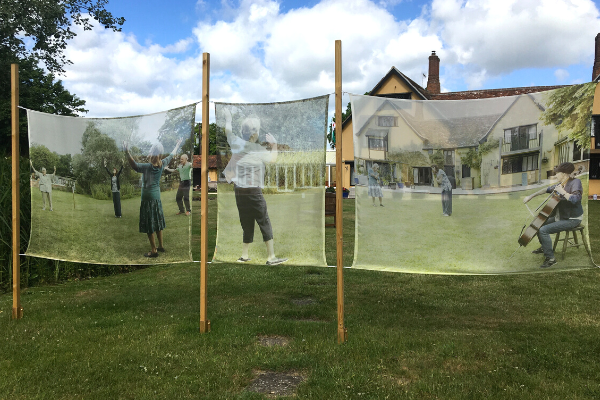
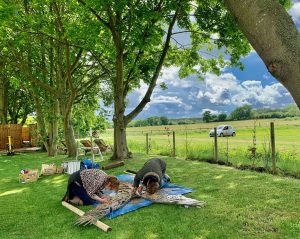
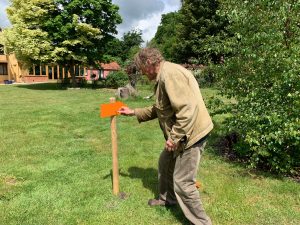
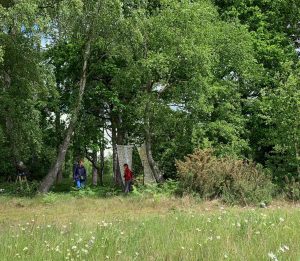


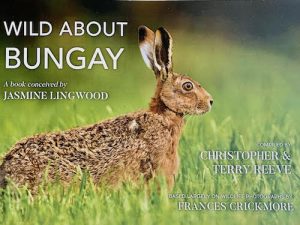
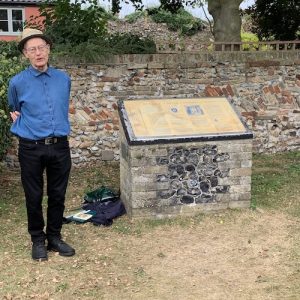
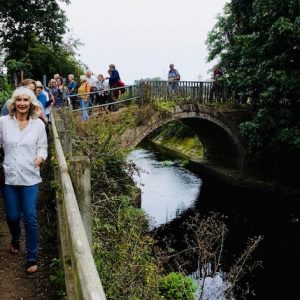 Our group of 20 walked through the water meadows on a footpath along the side of the river Waveney between Bungay and Earsham. We stopped frequently on the way to examine points of interest in nature that Jasmine had enjoyed in her lifetime: willow trees grown for making cricket bats; common alder trees that like their roots in water; common fleabane in flower; playing grandmother jump-out-of-bed by pinching the base of flowering convolvulus with its brilliant white, trumpet shaped flower.
Our group of 20 walked through the water meadows on a footpath along the side of the river Waveney between Bungay and Earsham. We stopped frequently on the way to examine points of interest in nature that Jasmine had enjoyed in her lifetime: willow trees grown for making cricket bats; common alder trees that like their roots in water; common fleabane in flower; playing grandmother jump-out-of-bed by pinching the base of flowering convolvulus with its brilliant white, trumpet shaped flower. accompanying us. We learned from their owner, farmer and photographer Frances Crickmore, that this herd had been imported from France when they decided to diversify their farming products to include cheese. This particular breed is known for their rich milk, and from it the Crickmore’s developed the now famous Bigot Brie cheese. The cows followed us along the footpath until we crossed over the river via a wooden bridge. Here we were joined by Frances Crickmore who introduced herself, told us about the farm and the land around us. She told us we could purchase the cheese in its signature circular wood box from a vending machine by the farm.
accompanying us. We learned from their owner, farmer and photographer Frances Crickmore, that this herd had been imported from France when they decided to diversify their farming products to include cheese. This particular breed is known for their rich milk, and from it the Crickmore’s developed the now famous Bigot Brie cheese. The cows followed us along the footpath until we crossed over the river via a wooden bridge. Here we were joined by Frances Crickmore who introduced herself, told us about the farm and the land around us. She told us we could purchase the cheese in its signature circular wood box from a vending machine by the farm.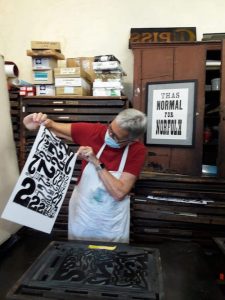
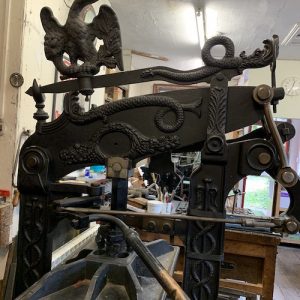 To say that Cupiss Letterpress is a hidden treasure of Diss is a bit of a cliche but true nonetheless, and all the more so because it’s closing down after nine years shy of two centuries in business.
To say that Cupiss Letterpress is a hidden treasure of Diss is a bit of a cliche but true nonetheless, and all the more so because it’s closing down after nine years shy of two centuries in business.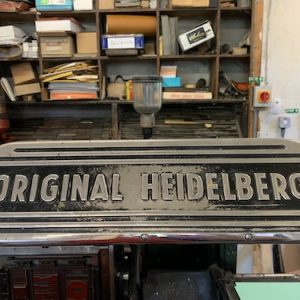 Inside the workshop, sited at the top of a track in the middle of Diss, John welcomed us and explained that the original business, established in 1830, wasn’t printing but for mixing and distributing a home-made medicinal horse “digestive”. The original recipe, in popular demand throughout the 20th century, was invented by the first Mr Cupiss. He needed to print labels for the dispensing bottles, and rather than find a supplier, he purchased his own printing press. As the demand for his horse digestive declined, so the print works grew and became a locally significant printing business.
Inside the workshop, sited at the top of a track in the middle of Diss, John welcomed us and explained that the original business, established in 1830, wasn’t printing but for mixing and distributing a home-made medicinal horse “digestive”. The original recipe, in popular demand throughout the 20th century, was invented by the first Mr Cupiss. He needed to print labels for the dispensing bottles, and rather than find a supplier, he purchased his own printing press. As the demand for his horse digestive declined, so the print works grew and became a locally significant printing business.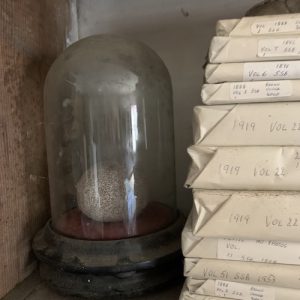
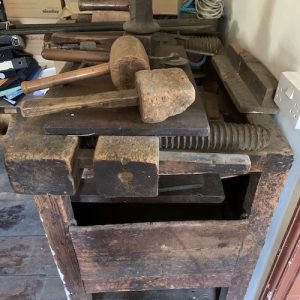 For me the overwhelming sense of a living history and indeed my learning on the day, was in the huge array of fonts and lettering. Tray upon tray, both beautiful and functional, the variety of fonts made from wood and lead were immaculately if chaotically stored. The wood ones hand carved, some acting as 3D ‘shadow’ had a fascinating appearance. The ‘upper case’ trays being capitals and the ‘lower case’ trays being, well, lower case. Another commonly used term originating in the printing business is ‘form’ which is the frame that holds individual letters in place ready for print.
For me the overwhelming sense of a living history and indeed my learning on the day, was in the huge array of fonts and lettering. Tray upon tray, both beautiful and functional, the variety of fonts made from wood and lead were immaculately if chaotically stored. The wood ones hand carved, some acting as 3D ‘shadow’ had a fascinating appearance. The ‘upper case’ trays being capitals and the ‘lower case’ trays being, well, lower case. Another commonly used term originating in the printing business is ‘form’ which is the frame that holds individual letters in place ready for print.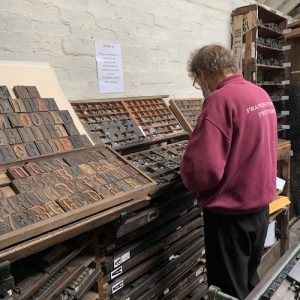
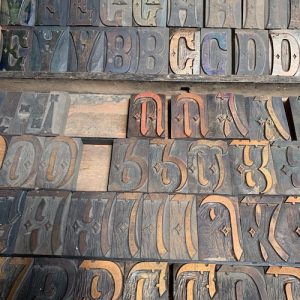
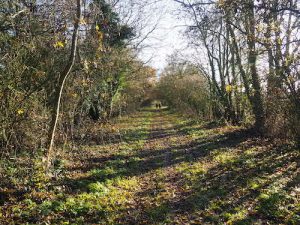
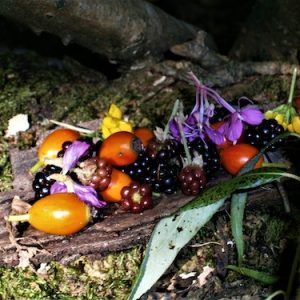
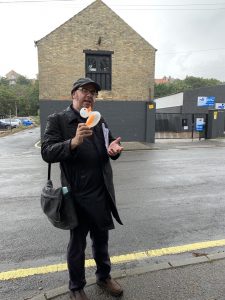
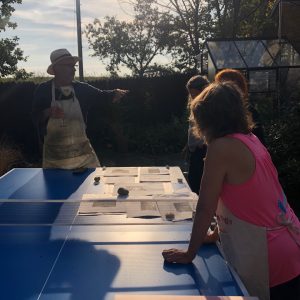
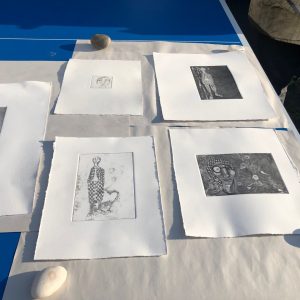 Mill Street Studios held two print workshops in the Summer and Autumn of 2021, which were run by Fine Artist and Printmaker, Catherine Greenwood who has a wealth of knowledge and expertise in printmaking and was an inspiration to all in her printmaking. We were able to learn and gain printmaking skills throughout the two-day workshop in hard and soft ground etching and collagraphy.
Mill Street Studios held two print workshops in the Summer and Autumn of 2021, which were run by Fine Artist and Printmaker, Catherine Greenwood who has a wealth of knowledge and expertise in printmaking and was an inspiration to all in her printmaking. We were able to learn and gain printmaking skills throughout the two-day workshop in hard and soft ground etching and collagraphy.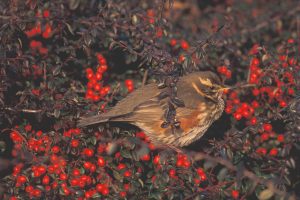
 wonder of a world that still contains so much mystery and magic. We must use all the creative arts we can to galvanise action, to make sure we are not the last generation to hear the cuckoo. Well done to the BTO for taking this initiative.
wonder of a world that still contains so much mystery and magic. We must use all the creative arts we can to galvanise action, to make sure we are not the last generation to hear the cuckoo. Well done to the BTO for taking this initiative.